Terror of the Black Hand (La Mano Nera) Society in America
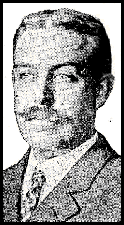
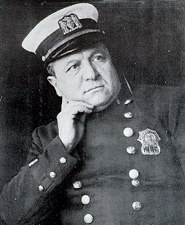
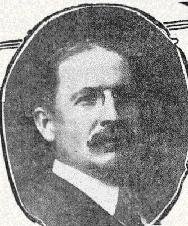
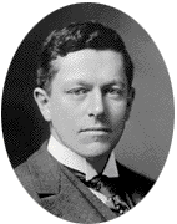
Images. Theodore A. Bingham. Giuseppe "Joe" Petrosino. John E. Wilkie and George Brinton McClellan.
The Black Hand society infiltrates the United States
Dumped ashore from the big immigrant ships, they settled in the slum districts of the metropolis. Many of them were from Sicily and others from the lower end of the Italian peninsula, which on the map looks like the heel and toe of a boot. This class was made up of criminals. All of them believed that there was more liberty in America and they came there expecting to carry on their criminality. Among them was Guiseppi (Joe) Morrello. Ignazio Lupo "The Wolf" Saietta, along with Joe Morello, and Nick and Vincent Terranova, formed the cruel Black Hand society. The symbol of their threat was a black hand impressed upon the letters (Black Hand" or "La Mano Nera" extortions letters) which they sent to their victims.
These letters demanded money on pain of swift and horrible death. "Money or we will murder you!' "Money or we will kidnap your children!" "Money or we will blow you and your house to bits!" Their victims were their fellow Italians and they were aware that refusal to comply with the demands of the criminals meant death.
The Black Hand hovered like a dark and threatening cloud over the daily life of thousands of Italians in New York as well as other cities throughout the United States where Italian colonies ‘Little Italies’ existed.
The Black Hand flourished wherever there were a number of Italians, drawing thousands of dollars from the pockets of its victims and leaving in its course a trail of blood and terror. The Black Hand was not the only secret society of criminals in the US. There were also the Mafia and the Camorra.
Guiseppi (Joe) Morrello and Ignazio Lupo "The Wolf" Saietta were at the head of Black Hand operations and counterfeiting, besides being suspected of other crimes
Crush the Black Hand
From 1901 onwards, the NYPD has been run by a single commissioner that solely ran the department. Theodore A. Bingham became commissioner of the NYPD in 1906.
General Bingham was a soldier and engineer in the US army. Though no longer in the US army, he was the commander of a corps of 9000 men, the police force of the greatest city. He could not mobilise this force in its entirety and go out after the Black Hand and crush it, because the Black Hand never fought openly. He had to approach the enemy by "underground" methods. The commissioner had organised a squad of 50 detectives to do secret work against the most infamous gang that ever infested civilization. Lieutenant Giuseppe "Joseph" Petrosino an Italian was in charged of the squad. Giuseppe "Joe" Petrosino (August 30, 1860 - March 12, 1909) was a New York City police officer who was a pioneer in the fight against organized crime.
On October 19, 1883 he joined the NYPD. Petrosino has struck terror into the hearts of bands of Italian crooks in lower Manhattan. Petrosino and his men made a remarkable number of arrests and there was a grand scatterment of the crooks. Scores fled over to Brooklyn and up town to the Harlem Italian colonies, while hundreds left the city altogether. The men who constituted the Black Hand bands in lower Manhattan have taken its methods of blackmail, murder, intimidation and perjury where the prey was easier and where there was no Joe Petrosino. The fact has been that the seperate bands throughout the country have been united in a freemasonary of crime. The Black Hand was now an organised criminal society in the United States.
Petrosino murdered on March 12, 1909
The murder of Petrosino at Palermo has caused an enormous sensation among the members of the Neapolitan Camorra, who said that the Black Hand condemned Petrosino to death in 1906. Lieutenant Joseph Petrosino of the New York Police Department (NYDP) was murdered at Palermo, Sicily, while he was securing evidence against the Black Hand society.
Bingham removed
1909. Bingham was removed from the commissionership of New York City by Mayor McClellan. He served as Mayor of New York City from 1904 to 1909. William Jay Gaynor succeeded him and served as Mayor from 1910 to 1913. William F. Baker, the first deputy commissioner, succeeded Bingham.
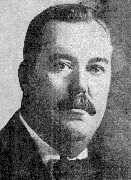
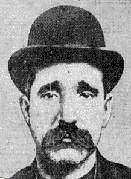
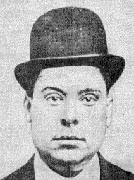
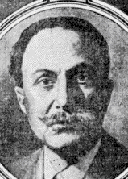
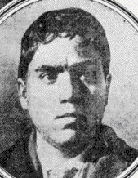
Images. William J. Flynn. Guiseppi Morrello. Ignazio Lupo "The Wolf" Saietta. Giovanni Calichio. Vincenzo Giglio.
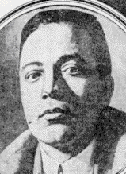
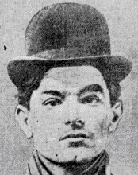
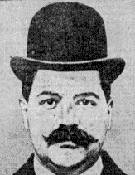
Images. Salvatore Cina. "Little Nick" Sylvestre. Antonio Cecala
Beginning of the end
Morello, although he had been arrested on suspicion of many other crimes, including murder, first came to the attention of the Secret Service in 1899 when counterfeit notes of $2 denomination flooded the East. William Flynn was assigned to the case. He did not succeed in convicting either Morello or Lupo. Flynn never forgot either, however, or for a moment relaxed his watch on them and in 1902, when he was Chief of the Eastern Division of the Secret Service and $5 counterfeits began to appear in the Italian district of New York, he knew where to look.
Flynn finally discovered that an Italian wholesale grocer, whom he knew to be friendly to Morello and Lupo, was importing an extraordinary quantity of Olive Oil under the tariff was admitted cheaper in barrels than in cans, so it was being shipped that way and the cans shipped seperately to be fitted in America. Flynn led a raid on the warehouse of the Italian merchant when the next consignment from Italy arrived and found cans filled with counterfeit $5 notes.
The notes were being printed in Naples and shipped to Morello and Lupo through their grocer confederate. As in the former case the grocer and other confederates of Morello and Lupo stoically took their punishment but steadfastly denied either of their leaders was concerned in the crime.
From the moment the pair left the courtroom Flynn's men shadowed them. They never lost them for a moment. One day in the summer of 1908 one of Flynn's operatives reported that Morello and Lupo had been talking to three other Italian criminals, Cina, Sylvestre and Palermo. Then the next day, the report came that the three had brought a fourth Italian, named Calichio, an engraver, to see Morello and Lupo. Flynn smiled.
Then a very important thing happened, a young Italian Antonio Comito met Cina on the street. He told him he was an immigrant printer and needed a job. Cina was delighted, for, you know, notes cannot be counterfeited without a printer. It was later found that Comito, Calabrian printer and schoolmaster, was forced under threats against his life to print bills for the Lupo-Morello gang in the Highland farmhouse.
In September, 1908, Cina purchased a farmhouse near Highland, NY. which is opposite Poughkeepsie. Immediately quiet unobtrusive, but very observant men, made their appearance about the railroad station at Highland and Poughkeepsie and also on the trains between those cities and New York whenever any of the suspected Italians rode on them. They were Flynn's operatives and the time and date of every trip made by any of the suspects was carefully noted.
By midwinter the plant was installed and running. Calichio sent plates to reproduce $5, $2 and $1 notes. Comito kept his presses humming. The notes as they were printed were taken to Morello and Lupo in New York City. Now was the time your average detective would have made his arrest. But not Flynn. He had as yet no legal evidence on Morello or Lupo. He was waiting for Morello and Lupo to visit the plant to that he might swoop down and capture them redhanded. Lupo came in February but Morello was not with him.
Again Flynn waited. In March Morello came, but Lupo had gone to Italy and Flynn did not arrest Morello, although through his witness he had evidence that both had visited the plant, which was what he needed to convict them, because he knew that Lupo probably never would return to the US if he received word of Morello's arrest. So again Flynn waited. So when shortly after Morello's visit, it was decided to close the plant, about $46,000 counterfeit money having been manufactured, he escaped.
In the early part of January, 1910, Lupo was reported again in New York. He was suppose to have entered through Canada or Mexico as all the Atlantic seaports were being watched for him. The time had come. Flynn gave the word. Lupo was arrested and simultaneously Morello and the others, with the exception of Comito, were taken into custody. Morello, Lupo and their confederates were serving long tems in the Federal Penitentiary at Atlanta, Ga.
According to newspaper reports 7 of them, including Lupo, were arrested in a farmhouse near Highland, NY, where they were making counterfeit American and Canadian money. Morello was arrested in New York and in his room. His wife was found sit- ting on a pile of letters which appeared to have sent to various merchants demanding money tribute to the band. The crime for which the 8 men were convicted was the making, at Highland, NY, of counterfeit bills and their circulation and sale to countrymen.
The Black Hand, said Chief of the Secret Service John E. Wilkie, has been dealt the severest blow in all its American history. The federal court in New York city sentenced to prison 8 Italians charged with counterfeiting that had been giving trouble for 10 years. But it did more. It cut the very heart out of the best organised gang that has ever used Black Hand methods on this side of the ocean.
Morello, leader of these counterfeiters, was, contrary to general believe, the chief of a gang that was responsible for 60% of the Black Hand extortion that has taken place in the United States in the past 10 years. Lupo the Wolf, who received sentence for counterfeiting at the same time and who was generally considered the chief of the Black Handers, was in reality but a tool of Morello and his outside man. Cina, Calicchio, Sylvestre, Giglio, Palermo and Cecala were the intimate associates. In the previous year 14 others were sent up for passing counterfeit money. They were lesser stars in the same notorious constellation.
The sentencing of the Morello gang was the last act in a blood spilling melodrama that had been running the 10 years. In it Morello and Lupo have played parts that would be hard to exaggerate in the most lurid fiction. In it there has been murder, blackmail, kidnaping, extortion, counterfeiting and fraud in a thousand phases.
The Italian in this saga who through his testimony in court sent Morello and the other 7 outlaws to the penitentiary was Antonio Comito who turned informer and state's evidence and was the government's chief witness in the case. Another Italian and former Black Hand convict, "Sam" Luchino also worked as an informer for the government. Giuseppe Monte, or Montado was convicted by the evidence of Luchino.
The Black Hand practice in the United States began to decline after 1915 and disappeared in the mid 1920s mainly due to tougher sentencing, federal mail laws, police raids and tighter immigration control - the best remedy was to prevent immigration of criminals from Sicily and Calabria. The trouble makers came either from Sicily or from the Calabrian peninsula. It was believed that the Black Hand society would meet the fate that befell the Molly Maguire society. A number of counties in Pennsylvania were terrorised by the Molly Maguires.
Members of that society were a bad lot. The Molly Maguires were a secret society of Irish coal miners in Pennsylvania in the period from the 1850's to the late 1870s. The Molly Maguires employed the traditional tactics of the Irish Secret Societies in combatting the ruthless mine owners in Pennsylvania. They used sabotage, violence and intimidation against the owners, overseers and their property. The mine and railroad owners hired the Pinkerton Detective Agency to infiltrate the Molly Maguires, which they did, amassing enough spurious "evidence" to bring some fifty Mollies to trial, twenty of whom were sentenced to death by hanging.